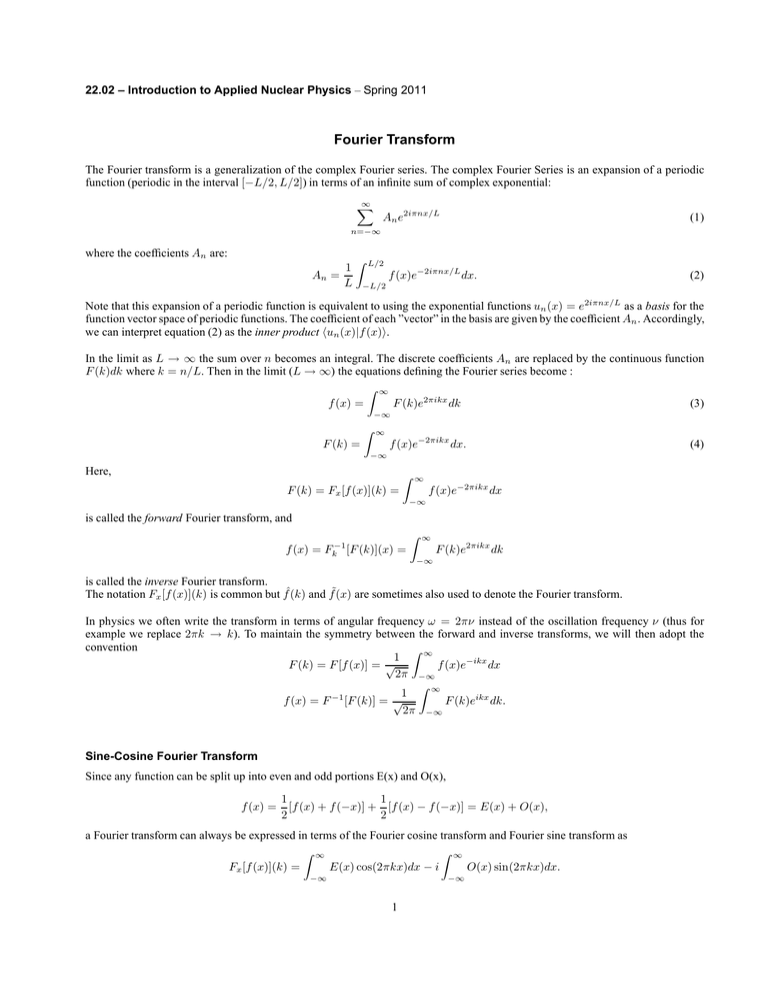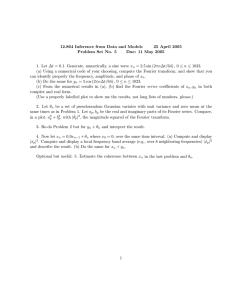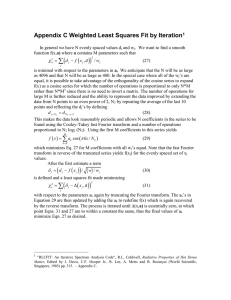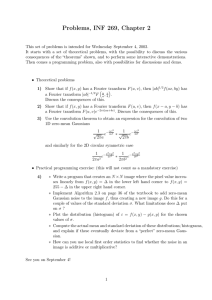Fourier Transform
advertisement

22.02 – Introduction to Applied Nuclear Physics – Spring 2011 Fourier Transform The Fourier transform is a generalization of the complex Fourier series. The complex Fourier Series is an expansion of a periodic function (periodic in the interval [−L/2, L/2]) in terms of an infinite sum of complex exponential: ∞ X An e2iπnx/L (1) n=−∞ where the coefficients An are: An = 1 L Z L/2 f (x)e−2iπnx/L dx. (2) −L/2 Note that this expansion of a periodic function is equivalent to using the exponential functions un (x) = e2iπnx/L as a basis for the function vector space of periodic functions. The coefficient of each ”vector” in the basis are given by the coefficient An . Accordingly, we can interpret equation (2) as the inner product hun (x)|f (x)i. In the limit as L → ∞ the sum over n becomes an integral. The discrete coefficients An are replaced by the continuous function F (k)dk where k = n/L. Then in the limit (L → ∞) the equations defining the Fourier series become : Z ∞ f (x) = F (k)e2πikx dk (3) −∞ F (k) = Z ∞ f (x)e−2πikx dx. (4) −∞ Here, F (k) = Fx [f (x)](k) = Z ∞ f (x)e−2πikx dx −∞ is called the forward Fourier transform, and f (x) = Fk−1 [F (k)](x) = Z ∞ F (k)e2πikx dk −∞ is called the inverse Fourier transform. The notation Fx [f (x)](k) is common but fˆ(k) and f˜(x) are sometimes also used to denote the Fourier transform. In physics we often write the transform in terms of angular frequency ω = 2πν instead of the oscillation frequency ν (thus for example we replace 2πk → k). To maintain the symmetry between the forward and inverse transforms, we will then adopt the convention Z ∞ 1 f (x)e−ikx dx F (k) = F [f (x)] = √ 2π −∞ Z ∞ 1 −1 f (x) = F [F (k)] = √ F (k)eikx dk. 2π −∞ Sine-Cosine Fourier Transform Since any function can be split up into even and odd portions E(x) and O(x), f (x) = 1 1 [f (x) + f (−x)] + [f (x) − f (−x)] = E(x) + O(x), 2 2 a Fourier transform can always be expressed in terms of the Fourier cosine transform and Fourier sine transform as Z ∞ Z ∞ Fx [f (x)](k) = E(x) cos(2πkx)dx − i O(x) sin(2πkx)dx. −∞ −∞ 1 Properties of the Fourier Transform • The smoother a function (i.e., the larger the number of continuous derivatives), the more compact its Fourier transform. • The Fourier transform is linear, since if f(x) and g(x) have Fourier transforms F(k) and G(k) , then Z Z ∞ Z ∞ −2πikx −2πikx [af (x) + bg(x)]e dx = a f (x)e dx + b g(x)e−2πikx dx = aF (k) + bG(k). −∞ −∞ Therefore, F [af (x) + bg(x)] = aF [f (x)] + bF [g(x)] = aF (k) + bG(k). • The Fourier transform is also symmetric since F (k) = Fx [f (x)](k) implies F (−k) = Fx [f (−x)](k) . • The Fourier transform of a derivative f’(x) of a function f(x) is simply related to the transform of the function f(x) itself. Consider Z ∞ Fx [f ′ (x)](k) = f ′ (x)e−2πikx dx. −∞ Now use integration by parts Z with Z vdu = [uv] − du = f ′ (x)dx and udv v = e−2πikx dv = −2πike−2πikx dx, u = f (x) then ∞ Fx [f ′ (x)](k) = f (x)e−2πikx −∞ − Z ∞ −∞ f (x) −2πike−2πikx dx The first term consists of an oscillating function times f(x) . But if the function is bounded so that lim x−→±∞ f (x) = 0 (as any physically significant signal must be), then the term vanishes, leaving Z ∞ ′ Fx [f (x)](k) = 2πik f (x)e−2πikx dx = 2πikFx [f (x)](k). −∞ This process can be iterated for the nth derivative to yield Fx [f (n) (x)](k) = (2πik)n Fx [f (x)](k). • If f (x) has the Fourier transform Fx [f (x)](k) = F (k) , then the Fourier transform has the shift property Z ∞ Z ∞ −2πikx f (x − x0 )e dx = f (x − x0 )e−2πi(x−x0 )k e−2πi(kx0 ) d(x − x0 ) = e−2πikx0 F (k), −∞ −∞ so f (x − x0 ) has the Fourier transform Fx [f (x − x0 )](k) = e−2πikx0 F (k). • If f (x) has a Fourier transform Fx [f (x)](k) = F (k), then the Fourier transform obeys a similarity theorem. Z ∞ Z ∞ f (ax)e−2πikx dx = 1/(|a|) f (ax)e−2πi(ax)(k/a) d(ax) = 1/(|a|)F (k/a), −∞ so f (ax) has the Fourier transform −∞ Fx [f (ax)](k) = |a|−1 F (k/a). • Any operation on f (x) which leaves its area unchanged leaves F (0) unchanged, since Z ∞ f (x)dx = Fx [f (x)](0) = F (0). −∞ 2 Table of common Fourier transform pairs. Function f (x) F (k) = Fx [f (x)](k) Constant 1 δ(k) δ(x − x0 ) e−2πikx0 Delta function Cosine cos(2πk0 x) 1 2 [δ(k Sine sin(2πk0 x) 1 2 i[δ(k + k0 ) − δ(k − k0 )] 1 k0 2 2 rπ k + k0 π −π2 k2 /a e a e−2πk0 |x| Exponential function 2 Gaussian e−ax Heaviside step function H(x) 1 [δ(k) − i/(πk)] 2 1 Γ/2 π (x − x0 )2 + (Γ/2)2 Lorentzian function In two dimensions, the Fourier transform becomes Z ∞Z F (x, y ) = −∞ = Z ∞ e−2πikx0 e−Γ π|k| f (kx , ky )e−2πi(kx x+ky y )dkx dky f (kx , ky ) −∞ ∞ −∞ Z ∞ F (x, y)e2πi(kx x+ky y )dxdy. −∞ Similarly, the n -dimensional Fourier transform can be defined for k , x in Rn by Z ∞ Z ∞ Z ∞ Z F (x) = ... f (k)e−2πik·x dn kf (k) = ... −∞ − k0 ) + δ(k + k0 )] −∞ −∞ 3 ∞ −∞ F (x)e2πik·x dn x. MIT OpenCourseWare http://ocw.mit.edu 22.02 Introduction to Applied Nuclear Physics Spring 2012 For information about citing these materials or our Terms of Use, visit: http://ocw.mit.edu/terms.







